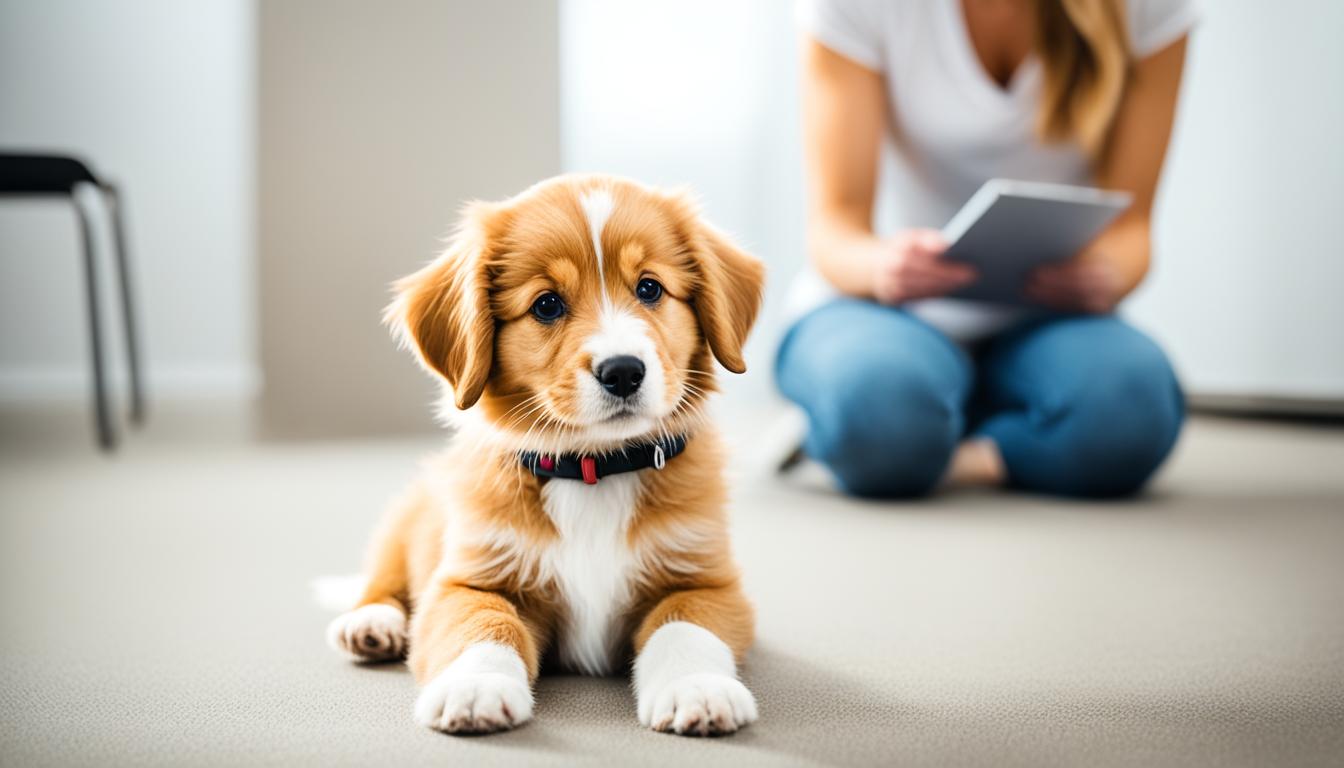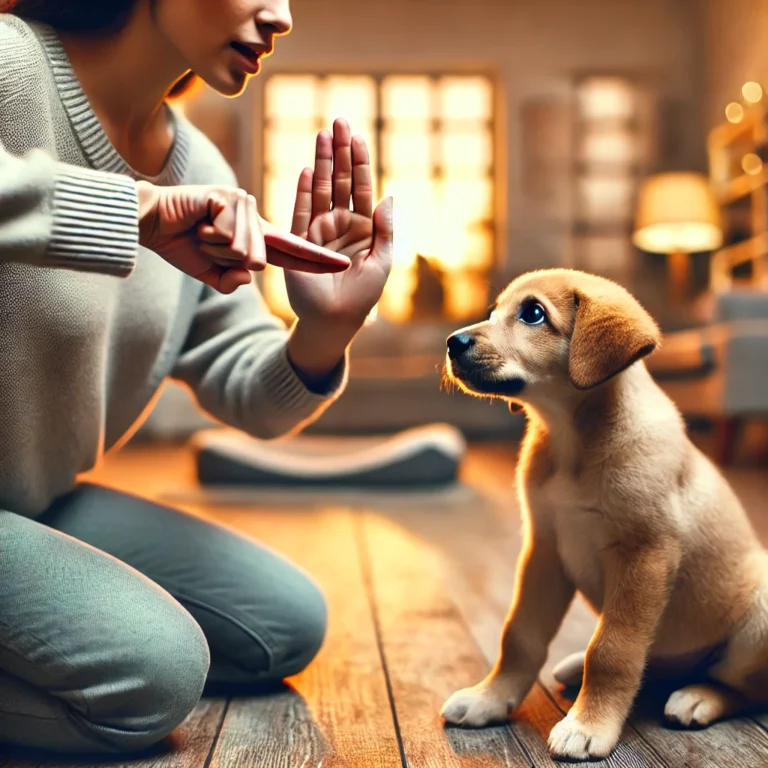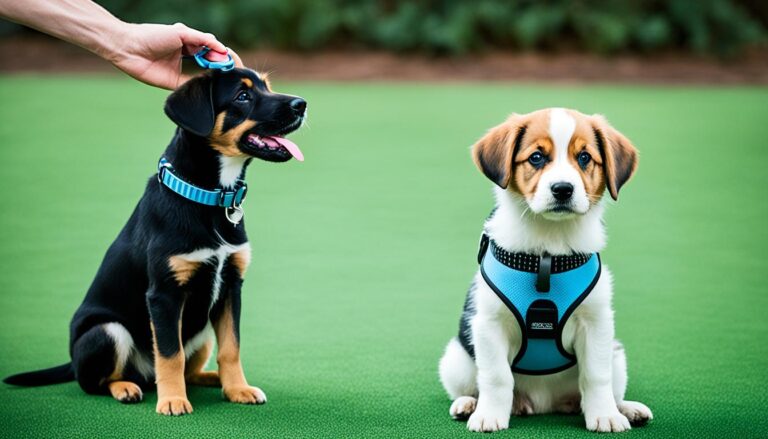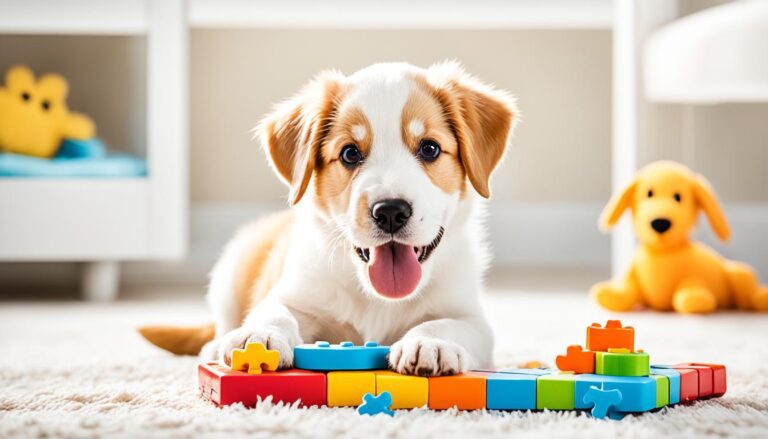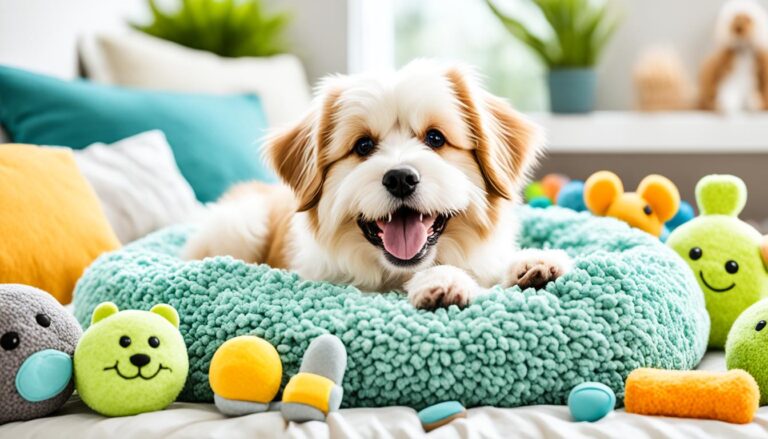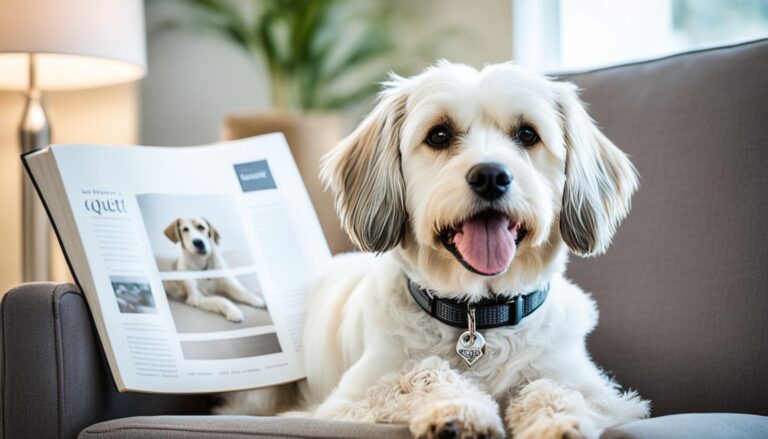Train Your Puppy for a Calm, Quiet Home Atmosphere
Did you know that a study conducted by the American Veterinary Medical Association found that 66% of dog owners cited excessive barking as their top behavioral challenge with their puppies? If you’re struggling to create a calm and quiet atmosphere at home, you’re not alone. Training your puppy to be calm and quiet is essential for their well-being and your sanity. Fortunately, with the right techniques and strategies, you can create a peaceful environment for both you and your furry friend.
Key Takeaways:
- Creating a calm environment is important for your puppy’s well-being.
- Provide access to food and water in a comfortable and stress-free area.
- Regular exercise and mental stimulation help reduce built-up energy and promote relaxation.
- Introduce pheromones or lavender essential oil for a calming effect.
- Playing classical music can help promote calm behavior in puppies.
Providing a Calm Environment for Your Puppy
To create a calm environment for your puppy, there are several techniques you can employ. By implementing these puppy calming techniques, you can ensure that your furry friend feels secure and at ease in their surroundings.
Access to Food and Water
It’s essential to provide your puppy with easy access to food and water in a comfortable area. Make sure their feeding station is located away from any sources of fear or anxiety, such as loud appliances or high foot traffic areas. This will help them feel safe while eating and drinking, reducing any potential stress or discomfort.
Regular Exercise and Mental Stimulation
One of the most effective ways to reduce puppy anxiety and create a calm environment is by incorporating regular exercise and mental stimulation into their daily routine. Taking your puppy for walks, playing games that require physical activity, and engaging in interactive play sessions will help release built-up energy and promote relaxation. Mental stimulation can be achieved through puzzle toys, training sessions, and activities that challenge their cognitive abilities.
Calming Scents and Music
Creating a soothing atmosphere for your puppy can be achieved through the use of calming scents and music. Pheromone diffusers, such as Adaptil, release synthetic calming pheromones that mimic the scent produced by mother dogs. Lavender essential oil is also known for its calming properties. Simply place a few drops of lavender oil on a cloth or cotton ball and place it near your puppy’s sleeping area. Additionally, playing classical music has been shown to have a calming effect on dogs, so consider incorporating calming melodies into your puppy’s environment.
Designated Space for Your Puppy
Providing a designated space for your puppy, such as a crate or established area, can give them a sense of security and a place to settle. Make sure their space is comfortable and includes items that provide comfort, such as a cozy bed or blanket. This will give your puppy a safe and secure place to retreat to when they need to relax and unwind.
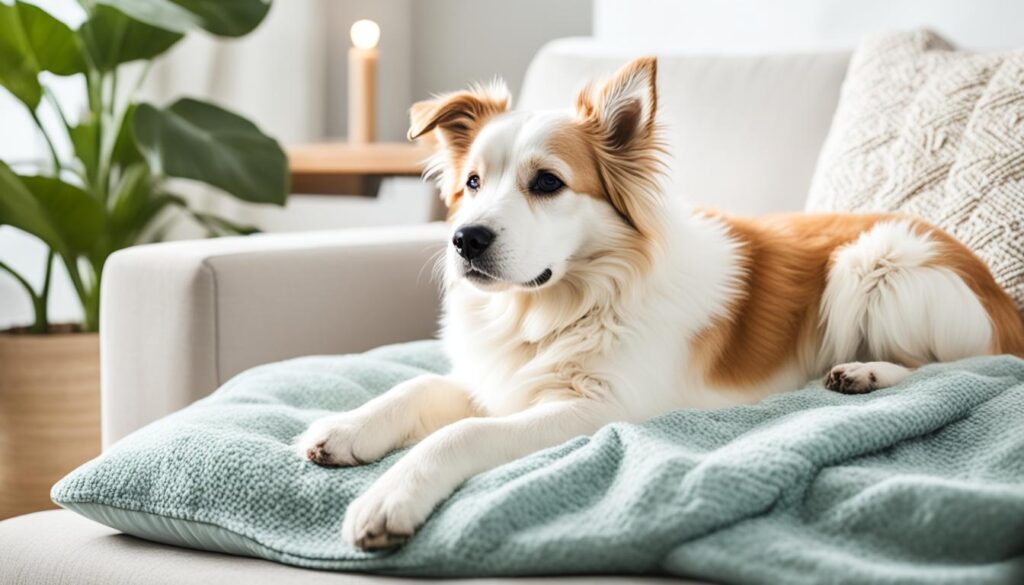
By implementing these puppy calming techniques and creating a calm environment for your furry friend, you can help reduce puppy anxiety and promote a sense of well-being. Remember, a calm and relaxed puppy is a happy puppy!
Establishing a Routine and Training
Establishing a routine is a key aspect of training a puppy to be calm and quiet in the house. Consistency and structure not only help your puppy understand expectations but also provide them with a sense of security and stability. Here are some essential elements to consider when establishing a routine:
1. Crate Training a Puppy
Crate training is an effective way to create a safe and secure space for your puppy, aiding in both potty training and ensuring their well-being. When properly introduced, a crate becomes a positive place where your puppy can relax, settle down, and sleep peacefully. Here are a few steps to follow when crate training:
- Choose an appropriate crate size that allows your puppy to stand, turn around, and lie down comfortably.
- Introduce the crate gradually, making it a positive and rewarding experience using treats and praise.
- Start with short periods of time in the crate, gradually increasing the duration as your puppy becomes more comfortable.
- Never use the crate as a form of punishment.
2. Teaching a Puppy to Settle
Teaching your puppy to settle on a designated mat or bed is an important skill that helps them learn how to relax and calm down in different areas of the house. This training exercise also provides them with a specific space where they can go to feel safe and comfortable. Here’s how you can teach your puppy to settle:
- Choose a comfortable mat or bed specifically designated for your puppy.
- Use positive reinforcement techniques such as treats or verbal praise to encourage your puppy to settle on their designated spot.
- Start by using short durations, gradually increasing the time your puppy spends on the mat or bed.
- Using a command such as “settle” or “place” can help your puppy understand what is expected of them.
3. Dog Obedience Training
Obedience training is crucial for creating a calm and well-behaved puppy. Teaching fundamental commands such as “sit,” “stay,” and “come” helps establish boundaries and reinforces your position as the leader. Here are some tips for effective dog obedience training:
- Use positive reinforcement techniques to reward your puppy for following commands.
- Keep training sessions short and frequent to maintain your puppy’s focus and attention.
- Be consistent with your commands, using the same words and gestures each time.
- Patience and repetition are key to your puppy’s learning process.
With consistent training and a structured routine, your puppy will develop good behavior habits and become a calm and well-adjusted member of your household.
Building Trust and Patience
Building trust and patience with your puppy is crucial for their overall behavior and ability to be calm and quiet in the house. By using positive reinforcement training methods, we can effectively modify unwanted behaviors and promote a sense of calmness. Encouraging and rewarding good behavior, such as responding to commands and settling down, can help shape their behavior positively.
Consistent sleep training is also essential in creating a calm and peaceful environment for your puppy. Providing a designated, calm, and quiet sleeping space for them helps promote better sleep patterns and reduces restlessness. This enables them to wake up feeling refreshed and more likely to exhibit calm behavior throughout the day.
Reducing puppy anxiety is another key factor in fostering a calm demeanor. Gradual introductions to new environments and objects help build their confidence and reduce fear and anxiety. Mental and physical stimulation, such as interactive toys, puzzle feeders, and regular exercise, keep their minds engaged and their energy levels balanced. By addressing anxiety, we can help our puppies become calmer and better equipped to handle various situations.
FAQ
How do I train my puppy to be calm and quiet in the house?
Training your puppy to be calm and quiet in the house requires creating a calm environment, establishing a routine, and building trust and patience. Providing access to food and water, regular exercise, mental stimulation, environmental scents, and classical music can help create a calm atmosphere. Having a designated space for your puppy, making changes gradually, and ensuring they have a calm environment are also important factors. Crate training, teaching your puppy to settle, and dog obedience training can contribute to a calm and well-behaved puppy.
How can I create a calm environment for my puppy?
To create a calm environment for your puppy, it’s important to provide access to food and water in a comfortable area away from any sources of fear or anxiety. Regular exercise and mental stimulation help reduce built-up energy and promote relaxation. Using pheromones or lavender essential oil can also have a calming effect on puppies. Playing classical music has been shown to promote calm behavior in dogs. Additionally, providing a designated space for your puppy, such as a crate or established area, can give them a sense of security and a place to settle.
How do I establish a routine and train my puppy?
Establishing a routine is important for training a puppy to be calm and quiet in the house. Crate training can provide your puppy with a safe and secure space, as well as help with potty training. Teaching your puppy to settle on a designated mat or bed can help them learn to relax in different areas of the house. Dog obedience training, including commands like “sit” and “stay,” can also contribute to a calm and well-behaved puppy.
How can I build trust and patience with my puppy?
Building trust and patience with your puppy is crucial for their overall behavior and ability to be calm and quiet in the house. Positive reinforcement training methods can help modify unwanted behaviors and promote calmness. Consistent sleep training, including providing a calm and quiet sleeping environment for your puppy, can also contribute to their overall calmness in the house. Reducing puppy anxiety through gradual introductions to new environments and objects, as well as providing mental and physical stimulation, is important for their confidence and ability to be calm.

